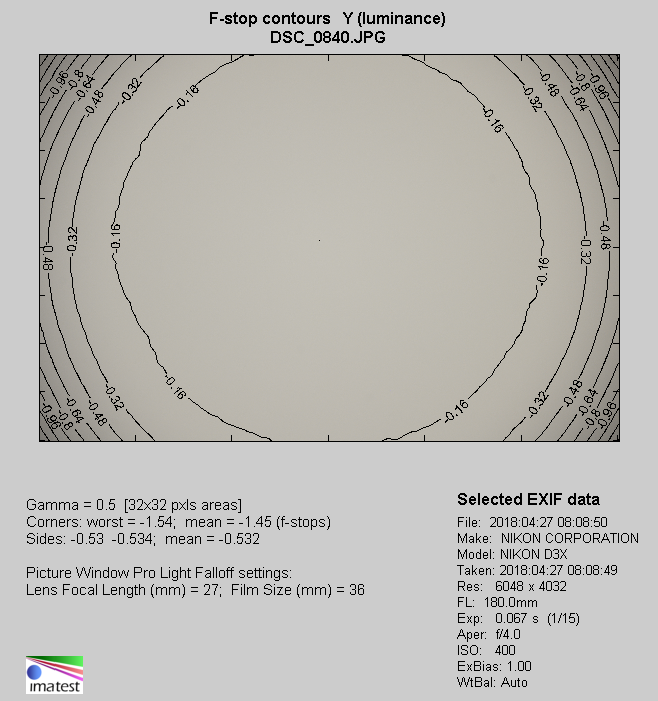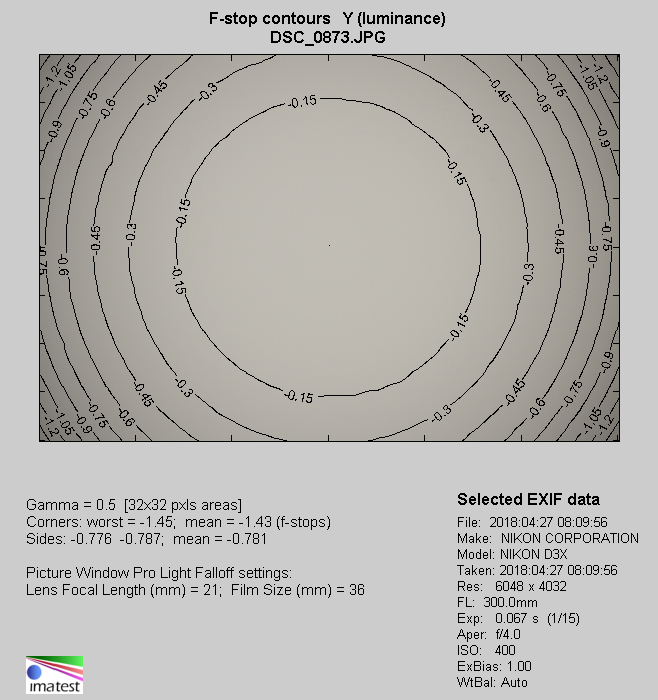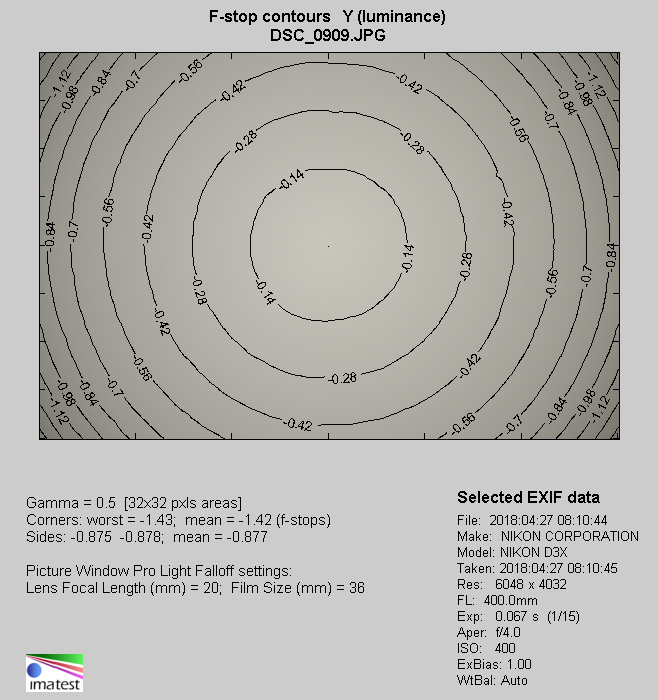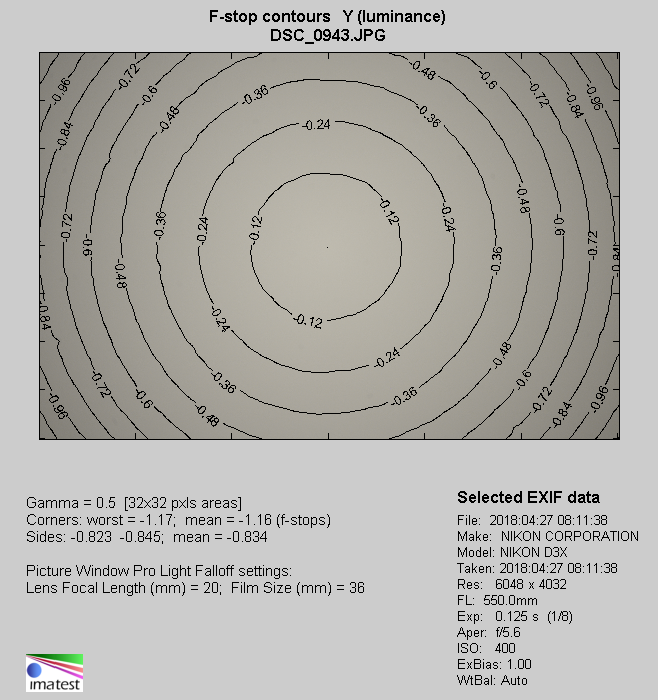Nikon Nikkor AF-S 180-400 mm f/4E TC1.4 FL ED VR
8. Vignetting
| Nikon D500, 180ámm, f/4.0 | Nikon D500, 180ámm, f/5.6 |

|

|
| Nikon D500, 300ámm, f/4.0 | Nikon D500, 300ámm, f/5.6 |

|

|
| Nikon D500, 400ámm, f/4.0 | Nikon D500, 400ámm, f/5.6 |

|

|
| Nikon D500, 550ámm (TC), f/5.6 | Nikon D500, 550ámm (TC), f/8.0 |

|

|
At shorter focal lengths that aberration won’t be noticeable at all. At 180 mm and by f/4.0 it is just 8% (−0.23 EV), and at 300 mm and f/4.0 it reaches 16% (−0.50 EV) to decrease to 3% (−0.09 EV) on stopping down the aperture to f/5.6. At 400 mm and the maximum relative aperture the vignetting gets to 22% (−0.71 EV) and decreases to just 6% (−0.19 EV) after employing f/5.6. Very similar results you can observe at 550 mm - by f/5.6 we officially got 21% (−0.67 EV), and by f/8.0 just 3% (−0.10 EV).
Please Support UsIf you enjoy our reviews and articles, and you want us to continue our work please, support our website by donating through PayPal. The funds are going to be used for paying our editorial team, renting servers, and equipping our testing studio; only that way we will be able to continue providing you interesting content for free. |
- - - - - - - - - - - - - - - - - - - - - - - - - - - - - - - - - - - - - - - - - - - - - - - -
Now let’s check how the situation changes as you progress to full frame. Below you can find thumbnails produced by the Nikon D3x camera.
| Nikon D3x, 180ámm, f/4.0 | Nikon D3x, 180ámm, f/5.6 |

|

|
| Nikon D3x, 300ámm, f/4.0 | Nikon D3x, 300ámm, f/5.6 |

|

|
| Nikon D3x, 400ámm, f/4.0 | Nikon D3x, 400ámm, f/5.6 |

|

|
| Nikon D3x, 550ámm (TC), f/5.6 | Nikon D3x, 550ámm (TC), f/8.0 |

|

|
In the case of the 180 mm focal length and the maximum relative aperture you don’t have any problems with noticing brightness loss as it amounts to 39% (−1.45 EV). That aberration decreases on stopping down so by f/5.6 you deal with a moderate level of 24% (−0.79 EV), and by f/8.0 you see a value of 15% (−0.46 EV). The aberration becomes imperceptible by f/11 and f/16, where it reaches respectively 11% (−0.33 EV) and 6% (−0.19 EV).
The results we got at 300 mm are very similar to those obtained at the shortest focal length. By f/4.0 you deal with light fall-off amounting to 39% (−1.43 EV), and by f/5.6 you see 22% (−0.73 EV) of brightness loss. By f/8.0 vignetting is 12% (−0.36 EV), and by f/11 just 7% (−0.20 EV).
After passing to the 400 mm focal length nothing changes. Once again by f/4.0 you deal with a value of 39% (−1.42 EV), and by f/5.6 the vignetting level is 21% (−0.69 EV). It decreases to 11% (−0.32 EV) after employing the f/8 relative aperture and becomes imperceptible by f/11 (5% and −0.16 EV).
After switching the teleconverter on the vignetting decreases to 33% (−1.16 EV) at the maximum relative aperture and to 14% (−0.43 EV) after employing f/8.0. By f/11.0 that aberration becomes completely imperceptible, reaching just 4% (−0.13 EV).
What’s interesting, at all standard focal lengths so in the range from 180 to 400 mm, and at the maximum relative aperture we got the same result, that of 39%. Still we show these thumbnails and isophotes for a reason. These 39% in the very corners of the frame can be reached in a completely different way and such is the case of this lens. At 180 mm you have a wide area completely vignetting-free; that aberration starts to increase very sharply close to the very corners of the frame. At 400 mm, for a change, vignetting appears closer to the centre and it increases slower as you move away from it.
| NikonáD3x, 180ámm, f/4.0 |
 |
| NikonáD3x, 300ámm, f/4.0 |
 |
| NikonáD3x, 400ámm, f/4.0 |
 |
| NikonáD3x, 550ámmá(TC), f/5.6 |
 |






